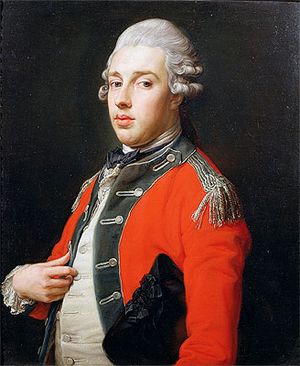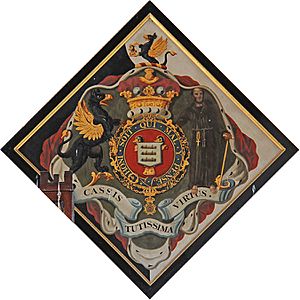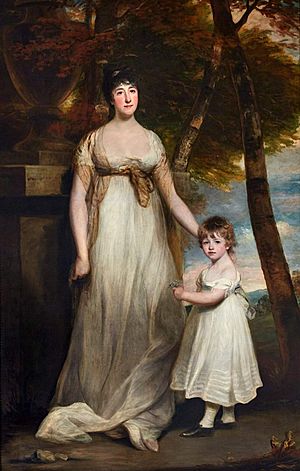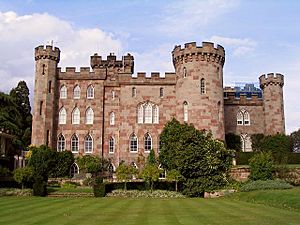George Cholmondeley, 1st Marquess of Cholmondeley facts for kids
Quick facts for kids
The Most Honourable
The Marquess of Cholmondeley
|
|
|---|---|

The Marquess of Cholmondeley by Pompeo Batoni, 1772, Houghton Hall, Norfolk.
|
|
| Lord Steward of the Household | |
| In office 19 February 1812 – 11 December 1821 |
|
| Monarch | |
| Prime Minister | The Earl of Liverpool |
| Preceded by | The Earl of Aylesford |
| Succeeded by | The Marquess Conyngham |
| Personal details | |
| Born |
George James Cholmondeley
11 May 1749 |
| Died | 10 April 1827 (aged 77) |
| Nationality | British |
| Spouse |
Lady Georgiana Charlotte Bertie
(m. 1791) |
| Children | George Cholmondeley, 2nd Marquess of Cholmondeley |
| Parents |
|
Meet George James Cholmondeley, the 1st Marquess of Cholmondeley. He was born on May 11, 1749, and passed away on April 10, 1827. He was an important British noble and politician.
Before becoming a Marquess, he held other titles. From 1764 to 1770, he was known as Viscount Malpas. Then, from 1770 to 1815, he was called The Earl of Cholmondeley.
Early Life and Education
George James Cholmondeley was the son of George Cholmondeley, Viscount Malpas, and Hester Edwardes. His grandfather was George Cholmondeley, the 3rd Earl of Cholmondeley. He was also a direct descendant of Sir Robert Walpole. Sir Robert Walpole was considered the first Prime Minister of Great Britain. George received his education at Eton College, a famous school in England.
Political Career
In 1770, when he was 21, George became the 4th Earl of Cholmondeley. This meant he got a seat in the House of Lords, which is part of the British Parliament. In April 1783, he joined the Privy Council of Great Britain. This is a group of advisors to the King. He was also made the Captain of the Yeomen of the Guard. This role involved leading the King's ceremonial bodyguards. He held this position until December of that year.
After being out of office for 29 years, he returned to government in 1812. He became the Lord Steward of the Household. This was an important role in the King's household. He continued in this job even after Lord Liverpool became Prime Minister. He served as Lord Steward until 1821.
Honors and Titles
In 1815, George received even higher honors. He was given the titles Earl of Rocksavage and Marquess of Cholmondeley. He was also made a Knight Grand Cross of the Royal Guelphic Order in 1819. In 1822, he became a Knight of the Garter. This is one of the most important honors in Britain.
Besides his political roles, he also served in local government. He was the Lord-Lieutenant of Cheshire from 1770 to 1783. He was also the Vice-Admiral of Cheshire from 1770 until his death in 1827. A place in southeast Alaska, called Cholmondeley Sound, was named after him in 1793. This was done by the explorer George Vancouver.
Family Life
Lord Cholmondeley married Lady Georgiana Charlotte Bertie on April 25, 1791. She was the daughter of Peregrine Bertie, 3rd Duke of Ancaster and Kesteven. Through this marriage, the old family role of Lord Great Chamberlain became part of the Cholmondeley family.
George and Georgiana had three children:
- George Horatio Cholmondeley, 2nd Marquess of Cholmondeley (born 1792, died 1870)
- William Henry Hugh Cholmondeley, 3rd Marquess of Cholmondeley (born 1800, died 1884)
- Lady Charlotte Georgiana (died 1828), who married Lt.-Col. Hugh Henry Seymour in 1818.
In 1797, he inherited Houghton Hall in Norfolk from his great-uncle Horace Walpole. However, he preferred to live at Cholmondeley Castle in Cheshire. He even helped redesign Cholmondeley Castle between 1801 and 1804.
Lord Cholmondeley passed away in April 1827 at the age of 77. His eldest son, George, inherited his lands, estates, and titles. Lady Cholmondeley died later in 1838.
Some historians believe Lord Cholmondeley might have inspired a character in a famous book. Professor Arthur Sherbo suggested he could be the real-life inspiration for Rawdon Crawley. This character is from the satirical novel Vanity Fair by William Makepeace Thackeray.
Images for kids
-
Cholmondeley's listing in the family vault at St Oswald's Church, Malpas





